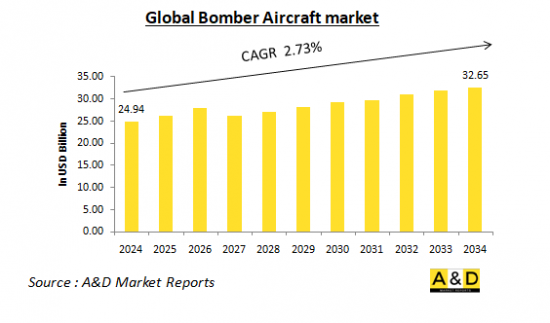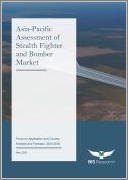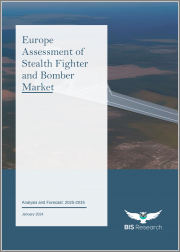
|
시장보고서
상품코드
1508611
세계의 폭격기 시장(2024-2034년)Global Bomber Aircraft Market 2024-2034 |
||||||
세계 폭격기 시장은 2024년 299억 4,000만 달러로 추정되며, 2024년부터 2034년까지 연평균 2.73% 성장하여 2030년까지 326억 5,000만 달러로 성장할 것으로 예상됩니다.

세계 폭격기 시장 개요
세계 폭격기 시장은 군용 항공에서 중요한 역할을 하고 있으며, 각국에 장거리 공격 임무와 억지력을 위한 전략적 능력을 제공합니다. 폭격기는 큰 페이로드(탑재량)의 탄약을 멀리 떨어진 목표물에 전달하도록 설계되어 전 세계 군사력에 필수적인 요소로 자리 잡고 있습니다. 폭탄, 미사일, 때로는 비정규 무기와 같은 무거운 탑재물을 탑재할 수 있는 능력이 특징이며, 전술적 지원에서 전략적 핵 억제에 이르기까지 다양한 역할을 수행합니다.
세계 폭격기 시장에서 기술의 영향력
기술의 발전은 폭격기의 능력과 효율성을 크게 변화시켰습니다. 현대 폭격기는 최첨단 항공전자, 스텔스 기술, 첨단 무기 시스템을 통합하여 생존성, 정밀 타격 능력, 작전 범위를 강화했습니다. 특히 스텔스 기술은 항공기의 레이더 단면을 감소시켜 분쟁 공역에서의 생존성을 향상시킵니다. 또한 재료 및 추진 시스템의 발전으로 연료 효율과 작전 내구성이 향상되어 폭격기가 연료 없이도 더 긴 임무를 수행할 수 있게 되었습니다.
디지털 통신 시스템과 '네트워크 중심 전투' 능력의 통합은 폭격기 함대 및 기타 군사 자산 간의 실시간 데이터 공유와 공동 임무 계획을 가능하게 합니다. 또한, 자율 비행 기술과 인공지능(AI)의 발전은 폭격기의 역할에 혁명을 가져와 복잡하고 분쟁이 많은 환경에서 자율적으로 활동할 수 있는 능력을 향상시킬 것으로 예상됩니다.
세계 폭격기 시장의 주요 촉진요인
세계 폭격기 시장의 성장과 발전에는 몇 가지 요인이 기여하고 있습니다. 첫째, 세계 지정학적 긴장이 고조됨에 따라 각국은 전략적 억제를 위해 고도의 폭격 능력에 대한 투자가 필요하게 되었습니다. 이러한 항공기는 잠재적 적대자에 대한 강력한 억지력 역할을 하며, 각국이 광범위한 범위에 걸쳐 힘을 투사할 수 있게 함으로써 국가 안보를 강화합니다. 둘째, 각국에서 진행 중인 군사 현대화 계획의 동향이 매우 중요한 역할을 하고 있습니다. 각국 정부는 빠르게 변화하는 세계 안보 환경에서 경쟁 우위를 유지하기 위해 자국 군의 역량 강화에 우선순위를 두고 있으며, 폭격기에 대한 투자는 이러한 노력에 필수적입니다. 셋째, 항공기 설계, 항공전자, 스텔스 기술, 무기체계의 지속적인 기술 발전은 폭격기 함대의 운영 효율성과 생존성을 크게 향상시킬 것입니다. 정부와 방산업체들은 폭격기 플랫폼에 최첨단 기술을 통합하기 위해 연구 개발에 막대한 투자를 하고 있으며, 이를 통해 폭격기가 군사 혁신의 최전선에 머물 수 있도록 보장하고 있습니다. 또한 장거리 탄약으로 정밀 타격을 제공하는 폭격기의 능력은 시장 수요를 촉진하는 중요한 요인입니다. 정밀 유도 무기를 통해 폭격기는 중요한 인프라, 군사 시설 및 고가 목표물을 최소한의 부수적 피해로 공격할 수 있어 전략적 관련성을 높일 수 있습니다. 마지막으로, 폭격기는 보통 재래식 전쟁과 핵 억제 전략 모두에서 역할을 수행할 수 있는 이중용도 능력을 가지고 있습니다. 이러한 다용도성으로 인해 폭격기는 국방 전략과 세계 군사 작전에 필수적인 자산이 되었으며, 현대의 국방 환경에서 그 중요성이 더욱 강조되고 있습니다.
세계 폭격기 시장의 지역별 동향
세계 폭격기 시장은 지정학적 요인, 국방비 지출, 기술 발전으로 인해 뚜렷한 지역적 역학을 보이고 있습니다. 북미, 특히 미국은 B-52 Stratofortress, B-1 Lancer, B-2 Spirit과 같은 상징적인 폭격기를 포함한 강력한 함대로 시장을 독점하고 있습니다. 미국은 스텔스 능력 강화, 첨단 항공전자 시스템 통합, 작전거리 연장을 위한 폭격기 현대화 프로그램에 막대한 투자를 지속하고 있습니다. 또한, 미국은 폭격기를 전 세계 전력 투사 및 전략적 억제를 위해 폭격기를 사용하고 있으며, 이는 세계 군사 전략에서 폭격기의 매우 중요한 역할을 강조하고 있습니다.
유럽 전체에서 영국, 프랑스, 러시아와 같은 국가들은 미국에 비해 규모는 작지만 활발한 폭격 능력을 유지하고 있습니다. 이들 국가는 진화하는 안보 위협에 적응하고 NATO의 방어 구상에 효과적으로 기여하기 위해 지속적인 현대화 노력을 우선순위에 두고 있습니다. 유럽연합(EU)과 NATO의 협력적 노력은 첨단 폭격기 기술의 공동 개발 및 조달을 촉진하고 회원국 간의 지역 방위 능력과 상호 운용성을 육성하고 있습니다.
아시아태평양에서는 국방비 증가, 영토 분쟁, 지정학적 긴장을 배경으로 폭격기 역량이 눈에 띄게 증가하고 있습니다. 중국은 H-6와 같은 플랫폼과 장거리 임무를 수행할 수 있는 전략폭격기 등 폭격기 함대의 대폭적인 확대로 눈에 띕니다. 인도와 일본도 지역 안보와 전략적 억지력을 강화하기 위해 폭격 능력을 강화하여 지역 안보 역학에 대응하고 군사 태세를 강화하고 있습니다.
중동 및 아프리카에서는 사우디아라비아, 이스라엘과 같은 국가들이 특정 지역 안보 문제를 해결하고 중동 전역에 영향력을 행사하기 위해 최신 폭격기 함대를 유지하고 있습니다. 이들 국가는 작전 능력을 강화하고 지역 내 잠재적 적대자들에 대한 전략적 억제력을 유지하기 위해 폭격기 현대화 프로그램에 대한 투자를 우선순위로 삼고 있습니다. 이러한 지역적 동향을 종합해 보면, 세계 여러 지역에서 세계 폭격기 시장을 주도하는 다양한 전략적 요구와 작전 요건이 있음을 알 수 있습니다.
폭격기의 주요 프로그램
Northrop Grumman은 미 공군으로부터 B-2 Spirit 스텔스 폭격기 현대화 및 역량 강화를 위해 최대 70억 달러 상당의 중요한 계약을 수주했습니다. B-2 함대의 성능을 유지 및 향상시키는 것을 목표로 하고 있습니다. 이번 계약은 B-2 함대 현대화의 중요한 이정표이며, 최종 퇴역 시까지 B-2 함대의 지속적인 유효성과 신뢰성을 보장하는 것입니다.
미국 국방부는 공군의 B-1 폭격기 지원 서비스를 제공하기 위해 보잉에 7억 5,000만 달러 상당의 5년 계약을 발주했습니다. 이 계약은 1년의 기본 기간과 4개의 1년 옵션을 포함하며 컴퓨터 네트워크 지원, 기술 분석, 비행 안전 분석, 잠재적 강화 작업 등 통합 엔지니어링 서비스 범위를 포함합니다. 이번 계약 체결은 국방부가 발표한 것으로, 국방부가 현재 진행 중인 폭격기 군단 유지 및 현대화 작업의 일환입니다.
본 보고서는 세계 폭격기 시장에 대해 분석했으며, 전체 시장 규모 동향 전망, 지역별/국가별 상세 동향, 주요 기술 개요, 시장 기회 등에 대해 조사하였습니다.
목차
폭격기 시장 : 보고서 정의
폭격기 시장 세분화
- 지역별
- 유형별
- 엔진 별
폭격기 시장 분석(향후 10년간)
폭격기 시장 기술
세계의 폭격기 시장 예측
폭격기 시장 : 지역별 동향과 예측
- 북미
- 시장 성장 촉진요인 및 억제요인, 과제
- PEST 분석
- 시장 예측과 시나리오 분석
- 주요 기업
- 공급업체 Tier 상황
- 기업 벤치마킹
- 유럽
- 중동
- 아시아태평양
- 남미
폭격기 시장 : 국가별 분석
- 미국
- 방위 계획
- 최신 동향
- 특허
- 현재의 시장 기술 성숙도
- 시장 예측과 시나리오 분석
- 캐나다
- 이탈리아
- 프랑스
- 독일
- 네덜란드
- 벨기에
- 스페인
- 스웨덴
- 그리스
- 호주
- 남아프리카공화국
- 인도
- 중국
- 러시아
- 한국
- 일본
- 말레이시아
- 싱가포르
- 브라질
폭격기 시장 : 시장 기회 매트릭스
폭격기 시장 : 조사에 관한 전문가의 견해
결론
Aviation and Defense Market Reports에 대해
LSH 24.07.17The global Bomber Aircraft market is estimated at USD 29.94 billion in 2024, projected to grow to USD 32.65 billion by 2034 at a Compound Annual Growth Rate (CAGR) of 2.73% over the forecast period 2024-2034

Introduction to Bomber Aircraft Market
The global bomber aircraft market plays a crucial role in military aviation, providing nations with strategic capabilities for long-range strike missions and deterrence. Bomber aircraft are designed to deliver large payloads of munitions to distant targets, making them essential components of military forces worldwide. These aircraft are characterized by their ability to carry heavy payloads of bombs, missiles, and sometimes unconventional weapons, fulfilling roles from tactical support to strategic nuclear deterrence.
Technology Impact in Bomber Aircraft Market
Technological advancements have significantly transformed the capabilities and effectiveness of bomber aircraft. Modern bombers integrate state-of-the-art avionics, stealth technology, and advanced weapon systems to enhance survivability, precision strike capabilities, and operational range. Stealth technology, in particular, reduces the aircraft's radar cross-section, enhancing its survivability in contested airspace. Moreover, advancements in materials and propulsion systems have improved fuel efficiency and operational endurance, allowing bombers to conduct longer missions without refueling.
The integration of digital communication systems and network-centric warfare capabilities enables real-time data sharing and collaborative mission planning among bomber fleets and other military assets. Furthermore, advancements in autonomous flight technologies and artificial intelligence (AI) are expected to revolutionize the role of bombers, enhancing their ability to operate in complex and contested environments autonomously.
Key Drivers in Bomber Aircraft Market
Several factors contribute to the growth and development of the global bomber aircraft market. Firstly, rising geopolitical tensions worldwide necessitate nations to invest in advanced bomber capabilities for strategic deterrence purposes. These aircraft serve as potent deterrents against potential adversaries and enable countries to project power over extensive distances, thereby bolstering national security. Secondly, the ongoing trend of military modernization programs across various countries plays a pivotal role. Governments prioritize the enhancement of their armed forces' capabilities to maintain competitiveness in a rapidly evolving global security landscape, with investments in bomber aircraft being integral to these efforts. Thirdly, continuous technological advancements in aircraft design, avionics, stealth technology, and weapon systems significantly enhance the operational efficiency and survivability of bomber fleets. Governments and defense contractors invest extensively in research and development to integrate cutting-edge technologies into bomber platforms, ensuring they remain at the forefront of military innovation. Moreover, the capability of bombers to deliver precision strikes with long-range munitions is a crucial driver of market demand. Precision-guided weapons enable bombers to target critical infrastructure, military installations, and high-value targets with minimal collateral damage, thereby increasing their strategic relevance. Lastly, bomber aircraft often possess dual-use capabilities, fulfilling roles in both conventional warfare and nuclear deterrence strategies. This versatility makes them indispensable assets for national defense strategies and global military operations, further underscoring their importance in the contemporary defense landscape.
Regional Trends in Bomber Aircraft Market
The global bomber aircraft market demonstrates distinct regional dynamics shaped by geopolitical factors, defense spending, and technological advancements. In North America, particularly the United States, dominates the market with a formidable fleet that includes iconic bombers such as the B-52 Stratofortress, B-1 Lancer, and B-2 Spirit. The US maintains substantial investments in bomber modernization programs aimed at enhancing stealth capabilities, integrating advanced avionics systems, and extending operational ranges. Furthermore, the US employs its bomber fleet for global power projection and strategic deterrence, underscoring its pivotal role in global military strategy.
Across Europe, nations like the United Kingdom, France, and Russia maintain active bomber aircraft capabilities, albeit on a smaller scale compared to the US. These countries prioritize ongoing modernization efforts to adapt to evolving security threats and contribute effectively to NATO defense initiatives. Collaborative endeavors within the European Union and NATO facilitate joint development and procurement of advanced bomber technologies, fostering regional defense capabilities and interoperability among member states.
In the Asia-Pacific region, there is notable growth in bomber aircraft capabilities driven by increasing defense expenditures, territorial disputes, and geopolitical tensions. China stands out with significant expansions in its bomber fleet, including platforms like the H-6 and strategic bombers capable of executing long-range missions. India and Japan are also augmenting their bomber capabilities to bolster regional security and strategic deterrence, responding to regional security dynamics and enhancing their military posture.
In the Middle East and Africa, countries such as Saudi Arabia and Israel maintain modern bomber aircraft fleets to address specific regional security challenges and exert influence across the Middle East. These nations prioritize investments in bomber modernization programs aimed at enhancing operational capabilities and maintaining strategic deterrence against potential adversaries within the region. Collectively, these regional trends underscore the diverse strategic imperatives and operational requirements driving the global bomber aircraft market in different parts of the world.
Key Bomber Aircrafts Program
Northrop Grumman has secured a significant contract worth up to $7 billion from the United States Air Force to modernize and enhance the capabilities of the B-2 Spirit stealth bomber fleet. The contract, which runs through 2029, aims to sustain and improve the performance of the B-2 fleet, which is expected to be retired in the early 2030s and replaced by the B-21 Raider. This deal marks a significant milestone in the modernization of the B-2 fleet, ensuring its continued effectiveness and reliability until its eventual retirement.
The U.S. Department of Defense has awarded Boeing a five-year contract worth $750 million to provide support services for the Air Force's B-1 bomber fleet. The contract, which includes a one-year base period and four one-year options, covers a range of integrated engineering services such as computer network support, technical analysis, flight safety analysis, and potential enhancement work. This contract award was announced by the Pentagon and is part of the Department of Defense's ongoing efforts to maintain and modernize its bomber aircraft fleet.
Table of Contents
Table of Contents
Bomber Aircraft Market Report Definition
Bomber Aircraft Market Segmentation
By Region
By Type
By Engine
Bomber Aircraft Market Analysis for next 10 Years
The 10-year bomber aircraft market analysis would give a detailed overview of bomber aircraft market growth, changing dynamics, technology adoption overviews and the overall market attractiveness is covered in this chapter.
Market Technologies of Bomber Aircraft Market
This segment covers the top 10 technologies that is expected to impact this market and the possible implications these technologies would have on the overall market.
Global Bomber Aircraft Market Forecast
The 10-year bomber aircraft market forecast of this market is covered in detailed across the segments which are mentioned above.
Regional Bomber Aircraft Market Trends & Forecast
The regional Bomber Aircraft Market trends, drivers, restraints and Challenges of this market, the Political, Economic, Social and Technology aspects are covered in this segment. The market forecast and scenario analysis across regions are also covered in detailed in this segment. The last part of the regional analysis includes profiling of the key companies, supplier landscape and company benchmarking. The current market size is estimated based on the normal scenario.
North America
Drivers, Restraints and Challenges
PEST
Market Forecast & Scenario Analysis
Key Companies
Supplier Tier Landscape
Company Benchmarking
Europe
Middle East
APAC
South America
Country Analysis of Bomber Aircraft Market
This chapter deals with the key defense programs in this market, it also covers the latest news and patents which have been filed in this market. Country level 10 year market forecast and scenario analysis are also covered in this chapter.
US
Defense Programs
Latest News
Patents
Current levels of technology maturation in this market
Market Forecast & Scenario Analysis
Canada
Italy
France
Germany
Netherlands
Belgium
Spain
Sweden
Greece
Australia
South Africa
India
China
Russia
South Korea
Japan
Malaysia
Singapore
Brazil
Opportunity Matrix for Bomber Aircraft Market
The opportunity matrix helps the readers understand the high opportunity segments in this market.
Expert Opinions on Bomber Aircraft Market Report
Hear from our experts their opinion of the possible analysis for this market.
Conclusions
About Aviation and Defense Market Reports















